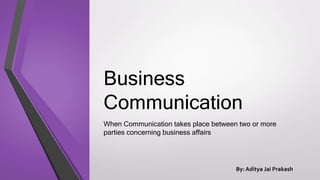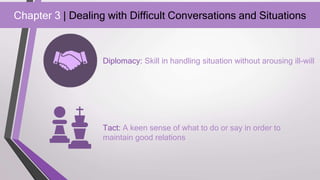Business communication
- 1. Business Communication When Communication takes place between two or more parties concerning business affairs By: Aditya Jai Prakash
- 2. Chapter 1 | Principles of Business Communication Passive Confident Aggressive Different kinds of Business Communication
- 3. Communication Styles Friendly Style Analytical Style Excitable Style Dominating Style
- 4. Conversation Enhancers âĒ Building Trust âĒ Demonstrating sincere interest âĒ Eye Contact âĒ Asking Questions âĒ Listening intently âĒ Rephrasing âĒ Responding
- 5. Conversation Killers âĒ Demonstrating lack of Interest âĒ Multitasking âĒ Pretending âĒ Closed-ended Questions âĒ Interrupting âĒ Insensitivity âĒ Making assumptions
- 6. How to build Rapport Respond. Listen. Ask Pertinent questions. Small Talks. Remember Names. Find Common Grounds. Give Sincere Praise. Honor Diversity. Become Bias Free. Respect.
- 7. Chapter 2 | Listening Focus fully on the speaker Focus on body language and non-verbal cues Avoid interrupting Listening is not the same as waiting for your turn to talk Avoid seeming judgmental The most difficult communication, when successfully executed, can lead to the most unlikely and profound connection with someone Show your interest in what's being said make sure your posture is open and inviting
- 8. Levels of Listening Pretending to listen Listening to respond Listening to learn Listening to understand Empathetic Listening
- 9. Type of Listeners The Preoccupied They are mostly occupied in something else Lost Ones Physically present but not mentally Interrupters They are focused instead on what to say Whatevers They remain aloof and donât care what is being said Combatives They will always disagree Analysts They constantly analyze and behave like therapists Engagers These are the consciously aware listeners
- 10. Chapter 3 | Dealing with Difficult Conversations and Situations Diplomacy: Skill in handling situation without arousing ill-will Tact: A keen sense of what to do or say in order to maintain good relations
- 11. Steps for Win-Win Decisions 1. What is the decision-making opportunity? 2. What are the options? 3. What are the pros and cons? 4. What is the best option? 5. What are the action steps? 6. Who is responsible for each step? 7. How will we track and measure each step? 8. How and when will we evaluate if this was the right decision?
- 12. Six Rules for Disagreeing Agreeably 1. Give others the benefit of doubt. 2. Listen to learn and truly understand others perspective. 3. Take responsibility for our own feelings. Make a commitment to respond using âIâ statements only. 4. Use a cushion: âI appreciate your point of view.â 5. Eliminate the word âbutâ or âhoweverâ from our vocabulary. 6. State our point of view or opinion with relevant and factual evidence.
- 13. Feedback Giving Feedback âĒ Get all facts. âĒ Address the situation promptly and privately. âĒ Focus on the act of behavior, not the person. âĒ Give the person genuine compliment first. âĒ First empathize, then criticize. Reveal your own similar mistakes, and tell what you did to correct them. âĒ Check your intentions. âĒ Use your human relations skills. Do not order, instead ask questions and make suggestions. âĒ Show the benefit of changing the behavior. âĒ End on a friendly note and agree on how to move forward.
- 14. Feedback Accepting Feedback âĒ Stay calm and hear the person out. âĒ Confirm your understanding of the situation. âĒ Be open to self-improvement and change. âĒ Trust that the person giving the feedback has good intentions. âĒ Do not react defensively. âĒ Donât offer excuses, provide facts. âĒ Thank the person for the feedback. âĒ Agree on how to move forward.
- 15. Chapter 4 | Art of Persuasion The Persuasion Steps Pick your battles Examine your values and beliefs Do your homework on the audience Use a clear and logical sequence to present ideas and provide evidence Present your ideas with confidence, passion, sincerity, and enthusiasm
- 16. Increase Credibility with EVIDENCE âĒ Demonstrations âĒ Examples âĒ Facts âĒ Representation of Stats âĒ Exhibits âĒ Analogies âĒ Testimonials
- 17. Chapter 5 | Master Emotions Emotional Intelligence (EI) âThe capacity for recognizing our own feelings and those of others, for motivating ourselves, and for managing emotions well in ourselves and in our relationships.â
- 18. How to Manage How to Manage Relationships: 1. Intuition and Empathy 2. Social skills and Political Correctness How to Manage Ourselves: 3. Self-Awareness 4. Self-management 5. Self-Expectations and Motivation


















